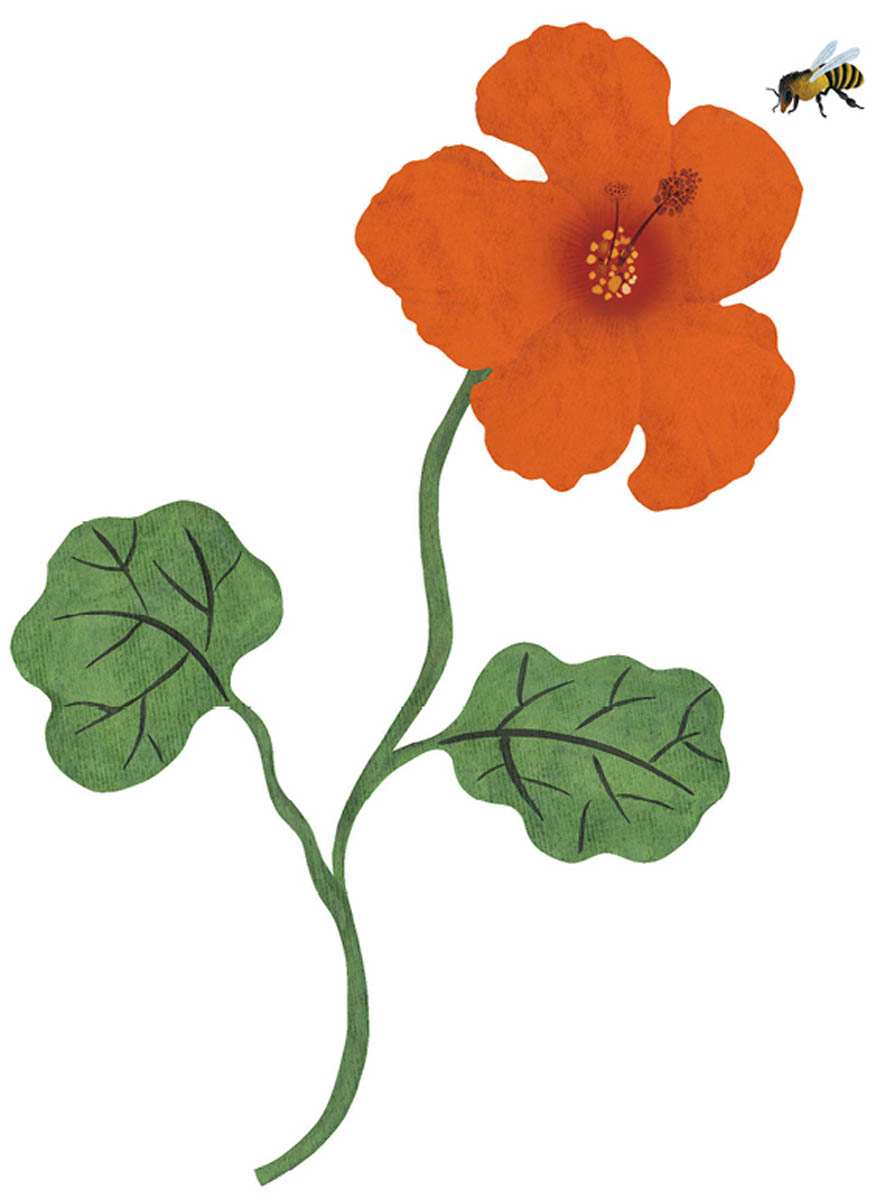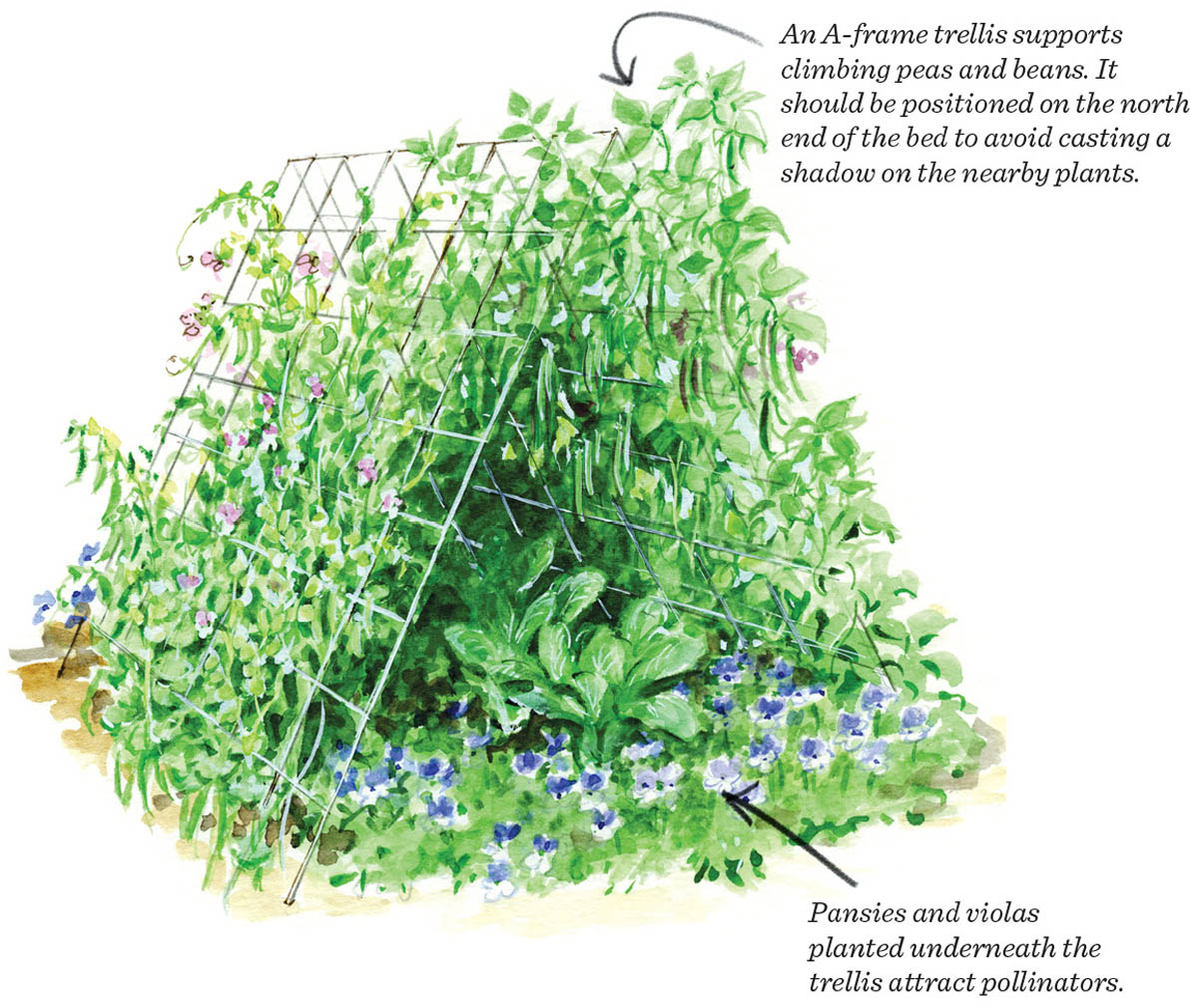
Paul Zammit knows the value of bees, butterflies, and other pollinators. He often chooses his garden plants — including edibles — based on the benefits they offer to pollinators. His design for a pollinator-friendly raised bed takes the guesswork out of planning for pollinators by including food for you and food for them. Gardeners will appreciate the pole beans and cherry tomatoes, while the bees and butterflies will gravitate toward the nasturtiums, borage, and catmint.
For a successful edible garden, Paul Zammit suggests you partner with pollinators by choosing pollinator-friendly plants, or by filling a container with some of his suggested plants and placing it near your garden. “These plants offer many benefits to an urban gardener, as well as the local insect populations,” he says. “Plus, they are aesthetically pleasing, edible, and promote a more diverse ecosystem, which is critical for pollinators.”

Picking for pollinators. Paul has long had an interest in how insects — particularly pollinators — are attracted to and use plants in the landscape. This has influenced how he selects and manages his plants. “When considering plants for the garden or for containers, I look very carefully at the values of each plant and I find myself asking how I can maximize the benefits,” he says, noting that he seeks plants with more than just one purpose. They may be beautiful, but can they also be eaten? Do they support pollinators? Referring to his home garden, Paul says, “I was always a fan of pinching out flowering stems of basil and coleus to promote more vegetative growth and foliage, but more recently I have observed bees and hummingbirds feeding on the blooms.” Now, when Paul finds himself in a “pinching mood,” he questions his actions and typically leaves some or all of the flowers to support these populations.
Training to trellis. To take advantage of unused vertical space, Paul has placed an A-frame trellis at one end of the garden to support climbing peas and beans. Beneath the structure, Paul suggests planting edible flowers such as pansies and violas, as well hardy greens like pak choi. Typically, these plants thrive in the cooler temperatures of spring and fall, but they can often be grown well into summer if they are given some shading from the hot sun.

Fabulous flowers. The pansies, violas, nasturtiums, borage, and calendulas serve several purposes in Paul’s design. First, they can be enjoyed for their bright flowers, which add cheer and color to the garden, but they also lure pollinating insects and birds to the neighboring edibles. Plus, the blooms are tasty and can be quickly tossed in mixed salads or used as a bed for fish or chicken.
In the center of the garden, two vining (indeterminate), small-fruited tomato plants grow up a trellis as espaliers, which keeps their rampant growth under control. Beside the trellis, an ‘Early Girl’ tomato produces larger fruits for summer sandwiches, homemade salsa, or bruschetta. A nearby row of spring greens is replaced in early summer with bush beans. Once the beans are harvested, the area can be planted with salad greens for autumn. There is also a row of curly parsley, which Paul likes to tuck into both his gardens and his containers. He likes parsley because it tastes and looks good, and because it’s an important food source for swallowtail butterfly larvae.
Birdbath with perch. A birdbath filled with stones and branches sits near the tomatoes. “Fresh water is so important for creatures of all sizes,” says Paul, adding that most of us only consider having water for the birds. At the Toronto Botanical Garden, he enjoys watching the honeybees land on stones and twigs in the water bowls and crawl to the edge of the water for a drink. Of course, a birdbath will also attract insect-eating birds to your garden, helping to control garden pests.

Planting for pollinators in vegetable gardens, as well as creating gardens purely to attract and support various types of pollinators, is a new trend in gardening. “Ever since we added beehives to the Toronto Botanical Garden, and with all the more recent issues regarding the status of bees, I have found myself really refining my plant selections,” reflects Paul. “More often than not, I catch myself questioning: Will this plant be a benefit to the bees, too? Really, who are we gardening for? We have such an amazing opportunity to do good through our passion for gardening.”
No space for a full-sized pollinator-friendly garden bed? Consider potting up a large container (18 to 24 inches in diameter) and filling with plants that support pollinator populations and provide fresh herbs and fruits for your family. You can place the pot in a sunny spot on a deck or patio, or site it near your vegetable garden or fruit trees to help entice more pollinators to your in-ground edibles. Include the following:


1. Trellis planted with spring-sown snow peas and pole beans; underneath, pak choi interplanted with violas and/or pansies
2. 1 ‘Juliet’ grape tomato and 1 ‘White Currant’ cherry tomato (espaliered)
3. ‘Early Girl’ tomato
4. Two rows of spring greens followed by bush beans
5. Nasturiums
6. Herb patch including rosemary, catmint, borage, basil, and calendulas
7. Birdbath with twigs and beach stones
8. Flat-leaved and curly parsley
9. Strawberries
10. Garlic chives
11. Thyme
12. Regular chives